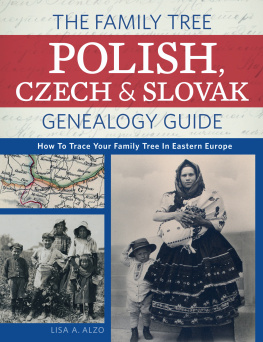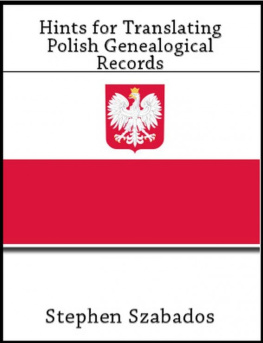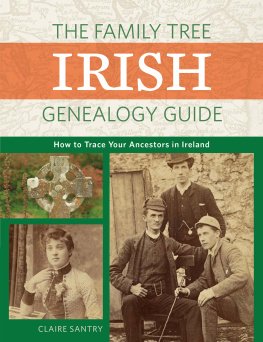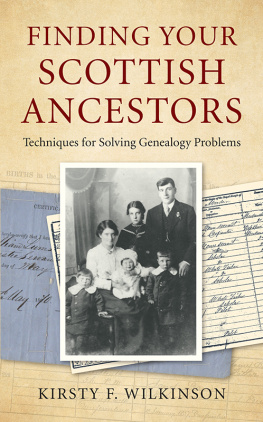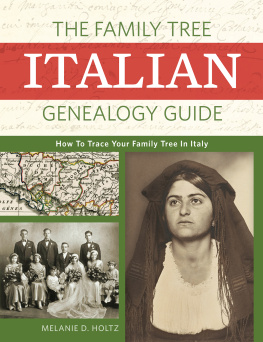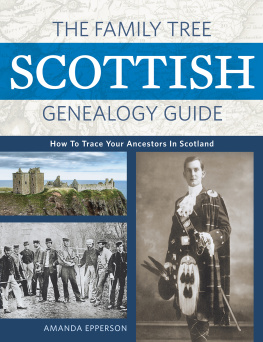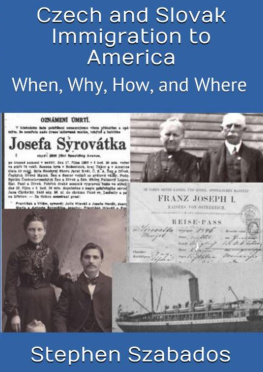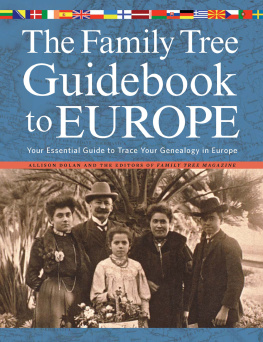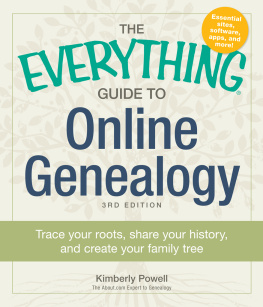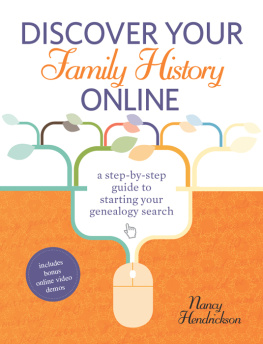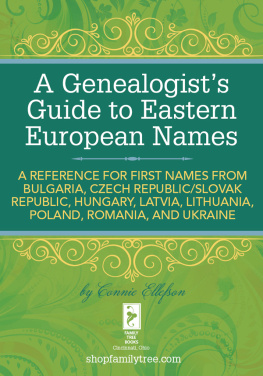Contents
Guide
THE FAMILY TREE
POLISH,
CZECH & SLOVAK
GENEALOGY GUIDE
How to Trace Your Family Tree in Eastern Europe
LISA A. ALZO

CINCINNATI, OHIO
shopfamilytree.com

DEDICATION
This book is dedicated to the memory of my grandparents and the countless other Slavic immigrants who had the courage to get on those boats. May the research we do continue to honor you and inspire future generations to understand their past.
Contents
CHAPTER 1
YOUR POLISH, CZECH, OR SLOVAK HERITAGE
Take pride in your Eastern European heritage. This chapter briefs you on why you should research your Polish, Czech, and Slovak ancestors.
CHAPTER 2
JUMP-STARTING YOUR POLISH, CZECH, AND SLOVAK RESEARCH
Maximize your research time by planning ahead. This chapter outlines how to identify your goals, build a family tree, and apply key genealogical principles.
CHAPTER 3
IDENTIFYING YOUR IMMIGRANT ANCESTOR
Unlock the two keys to European research: the name of your immigrant ancestor and his hometown. This chapter offers strategies for finding these crucial pieces of info that will guide the rest of your research.
CHAPTER 4
THE HISTORY OF POLAND
Dive into the turbulent history of Poland with this crash course guide to Polish history through the Commonwealth era, the partitions, the world wars, and beyond.
CHAPTER 5
THE HISTORY OF THE CZECH AND SLOVAK REPUBLICS
Catch a glimpse of these countries histories, from their time in the Austro-Hungarian Empire to the formation of Czechoslovakia and eventual independence.
CHAPTER 6
UNDERSTANDING EASTERN EUROPEAN GEOGRAPHY
Learn how geography shaped your ancestors lives by using maps, atlases, and gazetteers.
CHAPTER 7
LANGUAGES, SURNAMES, AND GIVEN NAMES
Master the mother tongue with these resources for learning the basics of the Polish, Czech, and Slovak languages and naming conventions.
CHAPTER 8
VITAL RECORDS
Discover the most basic wheres and whens of your ancestors life with this guide to birth, marriage, and death records.
CHAPTER 9
CENSUS RECORDS
Reach into the past to find where your ancestors lived in a given year. This chapter outlines where to find (and how to use) census records in Eastern Europe.
CHAPTER 10
MILITARY RECORDS
Follow the tracks your military ancestors left behind with this guide to military records from Eastern Europe.
CHAPTER 11
OTHER RECORD RESOURCES
Expand your research horizons with these resources you may not have thought to check. This chapter details how to use records like newspapers and local histories.
CHAPTER 12
HERITAGE TRAVEL AND ON-SITE RESEARCH
Walk a mile in your ancestors shoes with these helpful travel tips.
CHAPTER 13
PUTTING IT ALL TOGETHER
Check out these case studies from genealogists who have tracked down their Polish, Czech, and Slovak ancestors.
CHAPTER 14
WHAT TO DO WHEN YOU GET STUCK
Conquer your research roadblocks with this guide to resources for when your genealogical research comes to a standstill.
Introduction
When I began researching my Slovak ancestors in 1990, librarians, clerks, and even fellow genealogists were often puzzled by the surnames or ancestral locations I mentioned and would ask me, How do you spell that? or Where is that?
At one time, uncovering information about an ancestor who hailed from a tiny town located in the Czech Republic, Poland, or Slovakia, proved to be a challenging and often impossible task.
As a novice researcher, I found the border changes, exotic-sounding surnames, language differences, and political turmoil associated with navigating the former, massive Austro-Hungarian Empire tried my patience. Despite my dedication, many myths and misconceptions hindered my progress. Since then, I have meticulously tracked down and have even had the life-changing experience of visiting the birthplaces of all four of my grandparents in the modern-day Slovak Republic. It is my hope that this book will help other Czech, Polish, and Slovak researchers do the same.
In the past twenty-five years, I have had the good fortune of working with many skilled research colleagues who were instrumental in helping me navigate the complexities of Eastern European genealogy. My journey back to find my ancestors would not have been possible without the guidance of these mentors whose names are included later in this book. One of the biggest lessons I learned early on as a genealogist is the importance of collaboration and networking with those researching similar surnames or geographical areas. While researching our individual families, we might have a tendency to hold on tightly to knowledge gleaned from our efforts, but there is a lot to be said for sharing what we learn. Thanks to collaborative efforts with other East European genealogists, I have been able to break down many of my own research brick walls.
In the same collaborative spirit, this guide is designed to teach and inspire others who have an interest in exploring their Polish, Czech, or Slovak heritage.
Lisa A. Alzo
September 2015
PART 1
LINKING YOUR FAMILY TREE TO POLISH, CZECH, AND SLOVAK LOCALITIES
1
Your Polish, Czech, or Slovak Heritage
We all learn about our ethnic heritage in different ways. Perhaps you grew up hearing your Polish grandparents talking in a language you could not understand. Maybe you remember spending weekends at the local Czech Sokol or breathing in the delicious aroma of pska bread baking in your Slovak babas kitchen at Easter. Or perhaps you know little about your ancestors ethnic identity because your family assimilated into American culture over time, but something triggered your interest in genealogya celebrity-roots TV show, an Ancestry.com commercial, the discovery of a mystery photo, or the passing of a relative.
However you became inspired to learn more about your Polish, Czech, or Slovak ancestry, you likely have many unanswered questions as you embark on your genealogical journey. You are also part of a growing number of family history enthusiasts who are discovering that Eastern European research is not the nearly impossible task it was a few decades ago. Foreign archives and repositories (many of which are being made available digitally on the Internet) contain many useful and well-preserved documents, dispelling the myth that all the records over there were destroyed. Geographic and language tools can help you over the hurdles of pinpointing your ancestral town or village and understand the funny-looking script on your grandmothers baptismal record. This guide will teach you about the tools and techniques that will help you discover new information about your Polish, Czech, and Slovak ancestors.
Before we get started, its important to set the scope of this book. You may have heard Poles, Czechs, and Slovaks grouped together as Slavs. Indeed, if you look up Slavic on Wikipedia , you will read that present-day Poles, Czechs, and Slovaks are classified as West Slavic peoples. Likewise, Russians, Belarussians, and Ukrainians are often referred to as East Slavic, and Serbs, Bulgarians, Croats, Bosniaks, Macedonians, Slovenes, and Montenegrins are South Slavic. Despite some of the similarities you may see in food, dress, music, dance, or certain holiday customs or traditions, these groups of Slavs have plenty of differences to help you distinguish between them.

